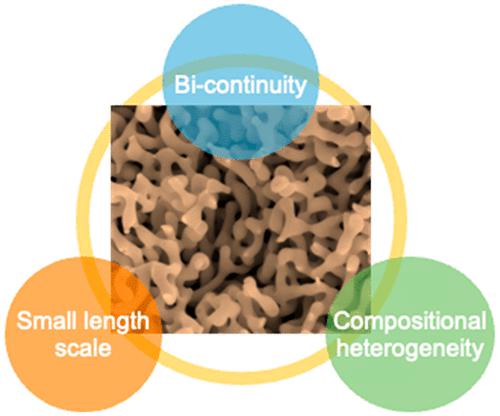当前位置:
X-MOL 学术
›
Chem. Mater.
›
论文详情
Our official English website, www.x-mol.net, welcomes your
feedback! (Note: you will need to create a separate account there.)
Bicontinuous Nanoporous Metals with Self-Organized Functionalities∇
Chemistry of Materials ( IF 7.2 ) Pub Date : 2022-11-16 , DOI: 10.1021/acs.chemmater.2c02697 Qing Chen 1
Chemistry of Materials ( IF 7.2 ) Pub Date : 2022-11-16 , DOI: 10.1021/acs.chemmater.2c02697 Qing Chen 1
Affiliation

|
The functional applications of bicontinuous nanoporous metals have been rapidly growing along with the fabrication methods of the materials. Besides the most common routes of electrochemical dealloying, liquid-metal dealloying, vapor-phase dealloying, and reduction-induced decomposition, all via similar mechanisms of interface-controlled self-organization have created a broad range of nanoporous structures made of noble metals (e.g., Au and Pt), refractory metals (e.g., Ti and Ta), and reactive metals (e.g., Al and Zn). They in turn enable new applications in catalysis, sensing, actuation, and electrochemical energy storage. Underlying the burgeoning development is the close connection between the functionalities and the structural evolution mechanism. In this perspective, I will dissect the structural complexity of bicontinuous nanoporous metal into three key features: the bicontinuity, the small length scale, and the compositional heterogeneity. I will discuss their roots in the self-organization process and their ties to properties such as mechanical strength, conductivity, and catalytic activity. The analysis will be centered around two aspects of the dealloying theory, namely, percolation and surface diffusion, showing how they can be applied to quantitatively understand the self-organized functionalities. In the end, I will also highlight emerging opportunities for structural designs to further advance the functional applications of the materials.
中文翻译:

具有自组织功能的双连续纳米多孔金属∇
双连续纳米多孔金属的功能应用随着材料的制备方法的发展而迅速增长。除了电化学脱合金、液态金属脱合金、气相脱合金和还原诱导分解等最常见的途径外,所有这些都通过类似的界面控制自组织机制产生了范围广泛的由贵金属制成的纳米多孔结构(例如、Au 和 Pt)、难熔金属(例如 Ti 和 Ta)和活性金属(例如 Al 和 Zn)。它们反过来又在催化、传感、驱动和电化学储能方面实现了新的应用。蓬勃发展的背后是功能与结构演化机制之间的紧密联系。从这个角度来看,我将把双连续纳米多孔金属的结构复杂性剖析为三个关键特征:双连续性、小长度尺度和成分异质性。我将讨论它们在自组织过程中的根源以及它们与机械强度、电导率和催化活性等特性的关系。分析将围绕脱合金理论的两个方面,即渗滤和表面扩散,展示如何应用它们来定量理解自组织功能。最后,我还将强调结构设计的新机遇,以进一步推进材料的功能应用。我将讨论它们在自组织过程中的根源以及它们与机械强度、电导率和催化活性等特性的关系。分析将围绕脱合金理论的两个方面,即渗滤和表面扩散,展示如何应用它们来定量理解自组织功能。最后,我还将强调结构设计的新机遇,以进一步推进材料的功能应用。我将讨论它们在自组织过程中的根源以及它们与机械强度、电导率和催化活性等特性的关系。分析将围绕脱合金理论的两个方面,即渗滤和表面扩散,展示如何应用它们来定量理解自组织功能。最后,我还将强调结构设计的新机遇,以进一步推进材料的功能应用。
更新日期:2022-11-16
中文翻译:

具有自组织功能的双连续纳米多孔金属∇
双连续纳米多孔金属的功能应用随着材料的制备方法的发展而迅速增长。除了电化学脱合金、液态金属脱合金、气相脱合金和还原诱导分解等最常见的途径外,所有这些都通过类似的界面控制自组织机制产生了范围广泛的由贵金属制成的纳米多孔结构(例如、Au 和 Pt)、难熔金属(例如 Ti 和 Ta)和活性金属(例如 Al 和 Zn)。它们反过来又在催化、传感、驱动和电化学储能方面实现了新的应用。蓬勃发展的背后是功能与结构演化机制之间的紧密联系。从这个角度来看,我将把双连续纳米多孔金属的结构复杂性剖析为三个关键特征:双连续性、小长度尺度和成分异质性。我将讨论它们在自组织过程中的根源以及它们与机械强度、电导率和催化活性等特性的关系。分析将围绕脱合金理论的两个方面,即渗滤和表面扩散,展示如何应用它们来定量理解自组织功能。最后,我还将强调结构设计的新机遇,以进一步推进材料的功能应用。我将讨论它们在自组织过程中的根源以及它们与机械强度、电导率和催化活性等特性的关系。分析将围绕脱合金理论的两个方面,即渗滤和表面扩散,展示如何应用它们来定量理解自组织功能。最后,我还将强调结构设计的新机遇,以进一步推进材料的功能应用。我将讨论它们在自组织过程中的根源以及它们与机械强度、电导率和催化活性等特性的关系。分析将围绕脱合金理论的两个方面,即渗滤和表面扩散,展示如何应用它们来定量理解自组织功能。最后,我还将强调结构设计的新机遇,以进一步推进材料的功能应用。











































 京公网安备 11010802027423号
京公网安备 11010802027423号